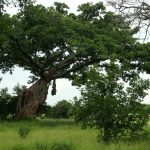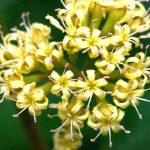TREE LIFE
JUNE 1990
MASHONALAND CALENDAR
Saturday 2nd June: Botanic Garden Walk. Park your car at the herbarium where we will meet Tom Muller at 1045 hours for 1100 hours.
Sunday 17th June: A treat this month – a visit to ‘Chipoli D” on the banks of the Mazowe River in the Shamva area and our hosts – Ian and Sue Jarvis. A bus has been booked and the far of $30 per person is still cheaper than running a car, taking AA rates, and sharing that cost amongst four people! We hope members of the Aloe and Cactus Society will be joining us. Bring some pennies if you are interested in buying Sabi Stars (large $10 and small $5) and Cycads ($30). It is quite a long way and we want as long a time as possible there – so the bus will leave at 0730 hours sharp. To reserve your seat phone Joy Killian before Thursday 14th on 308398.
Saturday 23rd June: All are welcome to walk with Mark Hyde who has found an interesting spot to explore on the Airport Road. Meet Mark at the corner of the Airport Road (formerly Queensway)and George Road at 1500 hours.
MATABELELAND CALENDAR
Sunday 3rd June: To Matopos to the Bambata Cave area once again. Meet at Retreat at 0830 hours. Bring lunch and chairs.
Sunday 1st July: To Matopos again for a morning or all day outing. The Young Ornithologists Club have asked us to teach their members (9 to 12 year olds) Trees and Birds. Meet at Retreat at 0830 hours and go to Eiffifi Picnic Site. There is a wealth of trees for the morning, then those who have had enough may depart. The rest, after lunch, will go on to lower Outspan for Tree Bingo.
MATABELELAND NOTES
On Sunday 6th May we went to the dam at Spring Vale Farm (Mr. P. Stork). After a dry passage through the Reserve by Esipizeni we came on a fine sheet of water surrounded by thick bush and trees. We identified some 55 species, including 7 Acacias, Acacia ataxacantha, A. chariessa, A. gerrardii many more than usual, A. karroo, A. nilotica, A. rehmanniana, A. sieberiana, Buddlja saligna, Cassine matabelica, with extra large leaves. 5 Combretum, C.apiculatum, C. erythrophyllum, C. hereroense, C. imberbe, C. molle, some varying Dichrostachys cinerea, Diospyros lycioides, fruiting, some largish

Diplorhynchus condylocarpon. Photo: Bart Wursten. Source: Flora of Zimbabwe
Diplorhynchus condylocarpon, Ehretia rigidas, Euclea divinorum, E. rapemosa, sub schimperi, Flacourtia indica, fruiting, Gardenia volkensii (spatulifolia), Grewia monticola, many, G. flavescens, few, Lantana camara, far too many Lippia javanica, flowering, Maytenus heterophylla, smallish leaves, Maytenus senegalensis, Olea europeae subsp. africana, very shiny and several large clumps, Ormocarpum trichocarpum, Ozoroa insignis subsp. reticulate, Pappea capensis, Piliostigma thonningii, Psydrax livida (canthium huilense), 3 Rhus, Rhus lancea, R. pyroides, R. tenuinervis, some small violet trees, only identified by the purplish samara type fruit, Securidaca longepedunculata, Steganotaenia araliacea, many, Ximenia caffra, many and some largish Ziziphus mucronata. Parasites Loranthus and Viscum were prominent in the area. By the time this is in print, we hope to have successfully completed our adventure trip to Tuli-Shashi with most welcome help from Harare members.
-C. Sykes
HARARE BRANCH TRIP TO VICTORIA FALLS : 17TH TO 19TH APRIL, 1990
It was more than twenty five years since I had been to the falls as a child, so the parched and faded memory of the grand natural phenomenon was greatly refreshed by this revisit and as an adult visitor I was left greatly moved. However, with my eyes open for the vegetation on this visit, the whole experience was made that much more rewarding. When one finally becomes bored with the mesmerising sight of the water falling and thundering into the chasm, one can then turn one’s attention to the trees.
On the first evening we really came in too late to take in much more of the falls and rainforest save to observe the column of ‘smoke’ and to take in the potato smell of Phyllanthus reticulatus which we did however see the following day. This is the shrubby little tree that carries the simple leaves on a little branchlet which falls at the end of the season, and misleads one into thinking that it has a compound leaf.
One begins to experience the rain forest as soon as one enters through the National Parks gate for already there the wind blows the occasional shower/mist/guti across from the falls and as soon as one enters this slightly wetter area the vegetation changes. Most interesting for me was my first encounter with
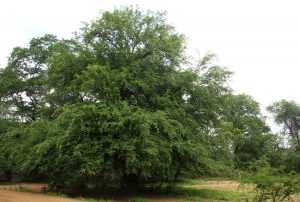
Pterocarpus lucens. Photo: Bart Wursten. Source: Flora of Zimbabwe
Pterocarpus lucens susp. antunesii, a tree considerably lower in height than the regular mukwa, with about two pairs of round leaflets with a terminal leaflet, these being smaller than those of P. rotundifolius. The most striking feature though is the deeply fluted bark. Indeed it is probably more correct to say that the trunk and branches are flattened and fluted in a most irregular fashion. At the same time, the outer bark is rather pale and peels off in smallish flakes. In this same forest, still a little way off from the falls was Olea europaea subsp. africana and a little further along, another familiar ‘face’, that of Strychnos potatorum with its typical three main veins from the base on the large rounded leaves.
This is the rain forest periphery, we came upon what appeared to be a boringly ordinary Croton gratissimus. Picture, if you please, the puzzled countenances of the Society members who were informed in authoritative tones that this was none other than C. menyhartii. All doubts were dispelled when the disbelievers were invited to lick the upper surface of a leaf. Unlike C. gratissimus, the leaf has a distinctly sandpapery feel. Not quite so obvious perhaps, but apparent once one gets the ‘feel’ for the trees is the rather shorter length of the leaf. Just a little upstream of the falls we did come across C. gratissimus enabling us to eliminate any feelings that we had merely been looking at a local variety of the latter.
The trouble with rain forests is that the main constituents are often too high to allow an examination of the leaves, so one is often left to try to sort out a variety of look alike trunks and bark. This was the feeling, at least at first, in the rain forest opposite the Devil’s Cataract and the main falls. The one with the grey, rather squarely fissured bark (though not quite ‘crocodile’ bark) was Diospyros mespiliformis. We got to know the leaves later. These tend to be the same sort of olive-green colour of D. kirkii though usually a little smaller and not quite so round. The other big trees, but with a fairly smooth bark, more yellowish in colour was Zyzgium quineense subsp, barotsense. I grope around trying to define the difference between this and S. cordatum and the common S. quineense both of which were also present. The leaf shape seems to be an intermediate between the other two. Also, the sub marginal vein which is so useful to confirm Zyzgium usually, is much less distinct here.
More likely to be confused with the Diospyros due to the general similarity of the bark and the size is Mimusops zeyheri, but one look at the glossy leaves reveals the significantly long petioles. The sap is milky, but one would not like to pull leaves off in a National Park to prove this, would one? Scattered about in the rain forest are considerable numbers of Phoenix reclinata, our wild date palm. The conditions seem to be ideal for these palms for most of them are remarkable for their great size. In a few cases they have evidently grown so tall that they have eventually fallen over and then resumed their vertical growth. No doubt it is trees like these that are the source of the specific name.
The forest harbours an interesting variety of fig trees. These included Ficus sur, some particularly fine F. sycomorus and F. ingens. The magnificent tangled strangling roots of a sizeable F. thonningii must sure have turned the heads of thousands of international tourists when finally they tired of gazing at the endless torrent. Perhaps the find of the day was another fig but one which we do not see often. This was Ficus nigropunctata characterised by the rather wavy leaf margin. It is also unusual within the figs because the branchlets are often dark (nigro) and are spotted (punctuated) with many white lenticels. These spots are only two to three millimetres long and are eruptions of corky cells that allow the branchlet to breathe. The special thing about this species was that, from a scan of the literature available, it did not appear to have been recorded previously from within the rainforest area itself, although it is known from the surrounding area.
In the under storey was the very familiar Friesodielsia obovata and rather more rare Carphalea pubescens. (There is no truth in the rumour that our chairman christened his car with this name after one or two gremlins misbehaved under his bonnet on the way down!) Though quite capable of achieving great size, the ‘yellow-blooded’ Garcinia livingstonei was here an under storey tree situated a short stone’s throw from the great explorer’s statue.
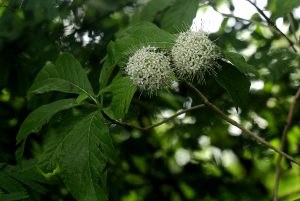
Pavetta cataractarum. Photo: Bart Wursten. Source: Flora of Zimbabwe.
Pavetta cataractarum is a rarity which occurs in the rainforest. It is the one with dots in the leaves like other Pavetta species, but the leaves are much larger and here it grows to tree size (at Chirundu it is just a shrub hardly taller than knee height. It was named after the falls. Flacourtia indica was easily recognised by the Bambazonkes but what really impressed them were the fearsome spines on the trunk, much branched and longer than we usually see.
Growing in the under storey of the rain forest was Byrsocarpus orientalis complete with its distinctive white lenticels on the branchlets. These are not like those on any other riverine tree. It is the tree that was photographed in the Botanic Garden when in flower and published in a book on the world’s most beautiful trees. Since then Tom Muller’s tree has died, although the one in the University garden is still there and looks good every year.
Phil Haxen.
WILLIAM TELL’S BUTTOCK AND KALAHARI SAND
Last night I dreamt I went to the Falls. The colonial grandeur of the Falls Hotel is impressive in a dream with its spectacular view of the continuous mists that rise from the falls and fall on the rain forest. The mist also falls onto the bridge that spans the second gorge, raining onto the passing railway carriages, just as Rhodes had dreamt it would do. But this dream was more real than Rhodes’ dream, partly because he died before the bridge was built but most because he never bothered to visit the falls. (subconscious dreams awaken the nurtured prejudices absorbed from my ouma –groetjie, she showed as much respect for Rhodes as my boerbul shows towards newly planted ranunculus tubers at $5 a dozen). In fact this dream was more than just real, it was surreal and there on the steps was Salvador himself, entranced by the landscape. I turned to see what it was he was expecting to find one of Gala’s eyes framed by the arch of the bridge? But no, his attention was focused on the trees. Yes these trees do attain a super reality, they are truly surreal. The musasas dwarf any found around Harare. I felt I needed to explain about the thick layer of basalt into which the Zambezi had cut its steep sided gorges. Maybe he did not know that this basalt was part of a huge sheet of lave that once stretched from coast to coast and all the way to Lesotho. Today it stretches at least as far as Bulawayo. That was a bare and hostile period in our history. Then came the great sand storms that blew in tons of dry Kalahari sand, these covered the solidified larva. Did Dali know that rain water drained through the coarse sand and formed a reservoir along the basalt? Could he see that these trees had their roots in this reservoir. That explained their size. Even in a dream it is all quite logical. But as I looked Dali left the steps and made his way to one of the tables laid with tea. Here the
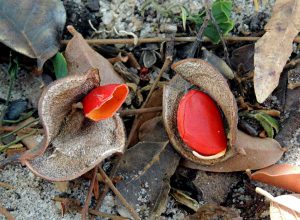
Guibourtia coleosperma. Photo: V. Williams. Source: Flora of Zimbabwe.
Guibourtia coleosperma provided dense shade. The two dark green leaflets on each leaf blew gently in the breeze. A magnificent specimen with a huge horizontal branch that was propped up with a crutch. Another crutch held up the musasa that shades the lunch time marimba band. And all at once I saw the smile on Dali’s face – the crutches! Crutches and Dali. Crutches that support William Tell’s buttock, crutches that prop up ‘sleep’. We were in a surreal landscape and all because the trees on Kalahari Sand had roots that reached the basalt. Then the dream stopped. I was left alone to discuss the vegetation on the Kalahari Sands at Victoria Falls.
The rain forest is on basalt. Remember that before the present gorge was formed the broad Zambezi flowed over this area and fell into what is now the second gorge. But as soon as you cross the railway line on the path to the Falls Hotel, the basalt is covered with coarse Kalahari Sand. The bare sand heats in the sun so that Jessica and Jemina were seen running from shade to shade. The shade is provided by Baphia massaiensis sub. obovata which were covered in the distinctive Baphia pods. We found a late flowering specimen in the camp site, it was densely covered in cascades of white pea like flowers. None of the specimens we saw was the coral pink colour of Tom’s Baphia in the gardens.
Baikiaea plurijuga (the Zimbabwean teak) is also common on the sands. The few specimens still had a few of the large purple flowers, but the main season was over. These would make superb garden trees except for the fact that they struggle to grow out of Kalahari Sand. Tom only succeeded when he imported truckloads of Kalahari sand. Their wood is highly prized for timber. So is the wood of Guibourtia coleosperma but apparently in this case it is the burls (knots) that are sought out. Fanshaw says that most of the trees with burls have been cut out.
On the path from the Falls Hotel to Makasa Sun we met up with 30 banded mongooses scampering across the lawn. This may be the same group that we saw feeding in the rain forest. Their path led them past a strange Diospyros with bunches of sweetly scented white flowers clustered on the old wood. This is Diospyros batocana which has a very limited distribution in Zimbabwe, only creeping into this far off corner. Not far off is a tall Erythrophleum africanum with alternate leaflets on the bi-compound leaves. A handsome tree with delicate foliage.
On the way back to the camp site we saw two enormous Acacia albida between the Post Office and the Railway Line. These were in new grey green leaf and with spikes of cream flowers. Around the camp site there is also a wealth of species on the Kalahari Sand. Ricinodendron rautanenii which resembles a baobab and has balsa light wood. And who could forget a tree called Amblygonocarpus andongensis, I had only ever seen this species in the Botanic Gardens. Ficus salicifolia (now F. cordata) and Gyrocarpus americanus grow near the offices along with baobabs in fruit. The huge Schrebera trichoclada reminds us once again of Dali who invented the term Cladelism after his fictitious character Solange de Cleda. Cledalism relates to sadism and masochism but refers to pleasure and pain sublimated in an all transcending identification with an object, rather an exciting sensation that may well relate to the sensuous trunks of Ochna pulchra that here attain a size unprecedented around Harare. Yes, there is a lot more to the Falls than curtains of water.
Kim Damstra.
NYARUPINDA CATCHMENT : APRIL/MAY 1990
Recently we went on horseback to get samples of dead wood from Lonchocarpus capassa, this belongs to the family FABACEAE and its timber has an interesting feature i.e. shiny, light refractive gum deposits and a well defined transport system for water and nutrients. When my companion saw what he had cut he said “Azeko varnisha”. He had expected to see dark coloured heart wood. A much larger dead stump was trimmed, that too, had no furniture. Lonchocarpus wood is pale coloured throughout and is tough for implement handles, grinding mortars and decorative carvings. Another tree with undifferentiated heartwood is Willow, these often become hollow with age because the heartwood decays since its paleness indicated the absence of tannins and waste products which harden the wood and act as preservatives.
Whilst on the topic of heartwood and sapwood it is worth mentioning that a forest tree such as Mukwa is managed so that it produces the maximum quantity of heartwood. On the other hand an orchard tree where the best possible water, nutrient and food transport system is needed to enable heavy crops of fruit, the tree is managed so as to slow down the encroachment of heart wood and increase the quantity of sapwood.
THE IMPORTANCE OF MEDULLARY RAYS
Rays are ribbon like masses of cells radiating outwards from the centre (medulla or pith) of the tree to the bark. Their position in the trunks and branches of trees enables rays to unite all the separate living parts of a plant. They are the “east-west” transport lines, for soluble nutrients. Also there are spaces filled with air between the ray cells which communicate with the atmosphere and with the intercellular spaces between all the living tissues of the bark and wood. Throughout these air spaces in the medullary rays oxygen, carbon dioxide and water vapour move across the stems of plants.
Some cells in the ray tissues store the products of photosynthesis and these are mobilised and pass into the sap when required. Broad rays feature in the genera Protea, Faurea, Grevilles and Macadamia. Medullary Rays are best seen in the tangential plane where they appear spindle shaped due to their height and width.
The medullary rays of Msasa, Mufuti and Mhondo are numerous but very fine and difficult to see on the grain i.e. in the transverse plane.
Another facet of the catchment is revealed now that autumn is in the air; Lannea discolor, Cussonia arboria, Zanha africana, Commiphora, Sterculia quinqueloba and Steganotaenia araliacea have changed colour and their leaves are falling.
In Europe the Horse Chestnut tree twigs were chosen to illustrate the preparations for leaf fall and subsequent dormancy. A suitable example here could be the carrot or pop gun tree, Steganotaenia araliacea. Perhaps it is not too late to observe this tree which clearly shows the gradual formation of lenticels and changes to the ‘skin’ of the twigs as bark is formed to seal the tree for winter.
Ripe black fruits of Flacourtia indica are an unusual sight here. Pleurostylia is flowering for the second time this year. Also flowering is Aloe christianii and Protea angolensis.
ZESA employees have pruned the Maerua triphylla and Cadaba termitaria down to the surface of the termite mound. These shrubs were in the vicinity of the Marula trees and were visited by members of the Tree Society when they came to Tinto.
The place where many
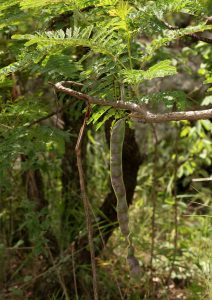
Elephantorrhiza goetzei. Photo: Bart Wursten. Source: Flora of Zimbabwe.
Elephantorrhiza goetzei grow has been located in a belt of woodland on a sand veld ridge. The curled stringy margins of the decayed pods indicate its presence. The maroon coloured buds on long spikes borne by leafless twigs are eagerly awaited. This tree is difficult to cultivate, would the elephant rhizomes reproduce the plant in lieu of the stubborn seeds? Has this been tried.
The answer to Question No. 1 of the Tinto Quiz has come from the Natural History Museum of Bulawayo. The tough elliptical cocoons containing pupae were those of Epanaphe clarilla belonging to the Group THAUMETOPOEIDAE which are Processionary Moths. Their caterpillars move in lines and are associated with species of Brachystegia.
“Earth Day” April 22nd 1990 passed without much ado. As a symbol of the role that trees play in maintaining a habitable environment a ‘Flaming Sphere’ poinsettia was planed at Tinto. A more optimistic symbol was the transplanting of a Trichilia emetica to more congenial surrounding.
Dickie Graves. Raffingora
MUKUVISI WOODLAND NOTES
The rains of April had a good effect on the Woodland, there is now more water in the Chiraura than there was two months ago. However, the rainy season, now past, has seen a low level of water in the underground streams. I have only noted worse in extreme drought years.
It is instructive to watch the feeding habits of mammals. Long after the sable catastrophe, spear grass (Hyperenia) was scarce. It has now recovered, also no sable to eat it. Eland took advantage of soggy ground in April to pushover some three metre high saplings of Terminalia sericea, they would normally have to break them off. This kind of ‘pushover’ is good business for an eland, if done right, the plant goes on living and there is a steady growth of new leaves at munching level.
Fruit bat middens can make seed collection easy. A veritable ‘seed bank’ in fact, at the right time it is possible to collect germinating seeds here. Uapaca and Parinari have big deposits in this bank.
Ficus sycamorus is a rare tree in the woodland, only a few on the vlei. The large specimen on the termite heap is always good for a few words on a guided walk. It is now robust, it is easy to forget that it has grown from ground level since the last hot fire over that heap in 1980. I often ponder on how difficult it is to guess the age of a tree from appearance. In absence of reliable record there is a tendency to over estimate age. I know I do this. There is one tree in Harare City Gardens, Ficus sur, which I think may have been growing there in 1890 when the City was founded. It stands on what would have been the vlei at the head of the stream which subsequently became known as Kingsway Drain. There also used to be a big F. ingens near the Monomatapa Hotel, until it was murdered in 1979. This may also have been a remnant of the pre 1890 flora. Fortunately, we have children of this big fig growing in the Woodland. Kingsway Drain later became important in providing a suitable habitat for that wonderful grove of palms – Washingtonia sp.
G. Hall
A CANOE TRIP continued
We had an exciting moment just before stopping at Rukomechi for tea. We were negotiating a narrow channel with high banks on either side, and all was peaceful, no hippos, Jim and I were the last canoe when suddenly some plovers flew up stridently calling and some cattle egrets too off and on the bank appeared 3 large hippo silhouetted against the sky who plopped into the water just behind us, then we had to paddle past Henry, a notorious hippo, but we managed to get safely by. We stopped in at Rukomechi for tea in a comfortable chair and a quick visit to a flushing toilet, music in our ears. It was while sitting on the loo that Jim overheard one of our guides saying to one of the Rukomechi staff – “they are real old time farming bokkies and they are very old friends who know each other very well, but hell they are terrible canoeists!!” This was where me met our New Zealand Chef, Anita, for the first time and her famed banana bread!
And so on to our camp for the night a little further down the river. A lovely late afternoon light bathed the river and a flock of red winged pratincoles took off as we landed, circled, and resettled on our island. If anything this site was more exposed than the first night and sheltered spots were not much in evidence as we set up camp. However, we were better prepared for digging holes for our hips, but not all of us slept very well.
While we were sitting around having our usual post wash pre dinner whiskies Ben had an idea that we should swop wives for the next day and he conducted a draw wherein Jim drew Charlotte and Ann drew Bob.
This night we erected our 2-man tents as we thought there might be rain about. However all was well and there was no rain so they were not used. They were very neat locally made tents and we did use them at Nyamepi (the camp site at Mana Pools).
Another early start and the first problem was a pod of hippo right as we left and we were instructed to hug the bank to keep as well away from them as possible. Well Jim and Charlotte did this so well that we ended up right on the bank and had to get off, turn around and on our way while the hippos huffed and snorted a few metres away. This was not much fun and there was a silent period in the canoe for some time!! There was a bit more excitement along these lines a little later on when a hippo actually did a bit of a mock charge at the group in front of us and the Tredgolds, who had drawn each other, and Mick and Vicky got all tangled up and had to be freed by the guide. All good fun.
We stopped for breakfast at around 8 that morning and as we wandered down stream on foot for a short distance we saw this most marvellous island, heavily wooded and the nesting site for hundreds of birds, open billed storks, greater egrets, yellow billed storks and sacred ibis. What a hive of activity, coming and going and a great cacophony of sounds, with an open billed stork flying along trailing clumps of hay. We canoed close by later but could have spent much longer. We had over 30km to go to Mana and we felt the guides were keen to get us on our way, just as well, as we had a slight hold up when Jim and Charlotte managed to hit a stump broadside and hole their canoe. Titch decided to test our manouvering skills and directed us into a channel and as we changed direction and were going sideways down the river there was this big bang and lo and behold Charlotte found herself sitting in a pool of deepening water. We had managed to hit a concealed stump and put a hole the size of a dollar in the bow of the boat. We managed to beach the canoe but a canoe with water in it is much heavier than usual and it took a little while to get the canoe beached. Nasty moment but we were not too far off shore when it happened. We all climbed out while the hole was cleaned and mended with Trinepon putty. Charlie recorded the process photographically and hopes Trinepon will send her a few supply in return for the advertising. We were held up an hour while the repair dried but enjoyed the opportunity to look at the trees and birds and watch a troop of baboons close by.
The bird life seemed to increase the further we went and I hear is even better beyond Mana, we saw carmine bee eaters, mostly immature birds who will not fly north this year, also white fronted bee eaters, flocks of white storks, fish eagles, martial eagles, vultures and many others gliding and circling overhead.
Lunch was again a welcome break and most of us managed some Egyptian PT. Before Mana we went through Trichilia alley, lined with marvellous specimens of Natal mahogany. We rounded a bend there were people along the banks, one almost feels cheated, and very selfish about having to share the tranquillity. We pass the lodges at Mana and finally get to our final landing spot. The trailers were waiting and all the men helped to load the canoes. We are very disappointed with the state of the camp. A very popular National Parks site and so sad to see rubbish from last season still lying around and the facilities unkempt. We pitch our tents on the sand below and enjoy our last evening perching on camp stools and telling more stories only marred by the armoured crickets who were around in large numbers, harmless, but not very nice looking and cannibal in habit feeding on any colleague who got squashed or run over. The mosquitoes were more in evidence but we had a pretty good night in our tent. That’s what Ann says but nobody asked me.
In the morning we discovered a hippo had walked between the Tredgold’s and ourselves. Lucky he did not step a couple of feet sideways or would have walked on my head!. We rose early and packed up everything, saw all the Safari equipment loaded onto the land rovers to Kariba and then we settled down to wait for the motor boats to take us back to Rukomechi for breakfast. Troy Williamson arrived an hour late on his own, Ben’s boat had a problem, so the girls were sent on with Ben in the Rukomechi boat, a beautiful 115hp Yamaha sending the load speeding up the river. We were speeding along when a warning signal went off and the engine died, we caught onto some branches to stop us drifting back – we were on the Zambian side and did not relish the thought of being stranded there. But Ben and Troy sorted out the problem and we were on our way again and soon being welcomed by the staff of Rukomechi, Brian Worsley and Lindy Steyn. More Melsetter connections as Brian is John and Shelagh’s son and a marvellously knowledgeable person and very pleasant too. Lindy is the daughter of Peter Steyn of bird fame who was at Bishops and then taught at Falcon many years ago and a great friend of the Tredgolds. Brian and Lindy jointly run safaris by road from the Falls to Kariba and the trip sounds like a great experience. More next month
DICK HICKS CHAIRMAN


